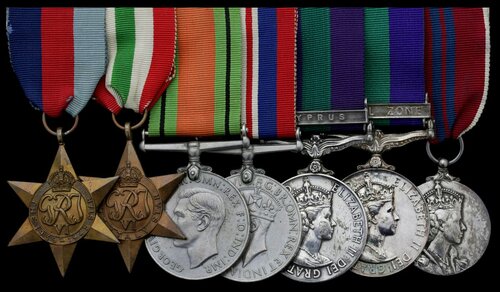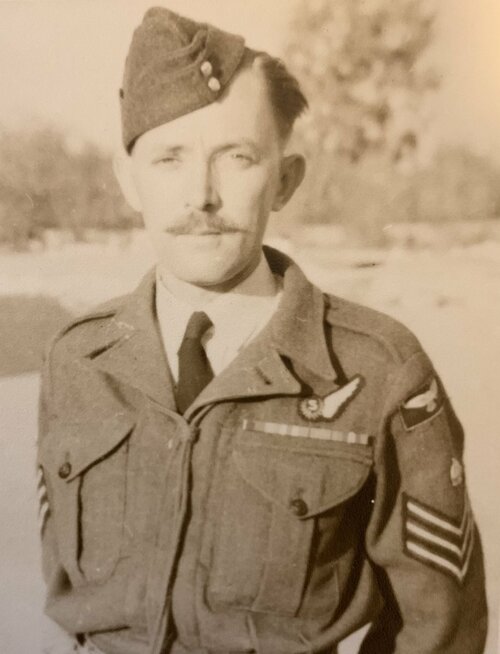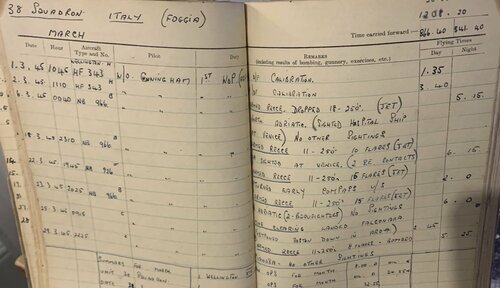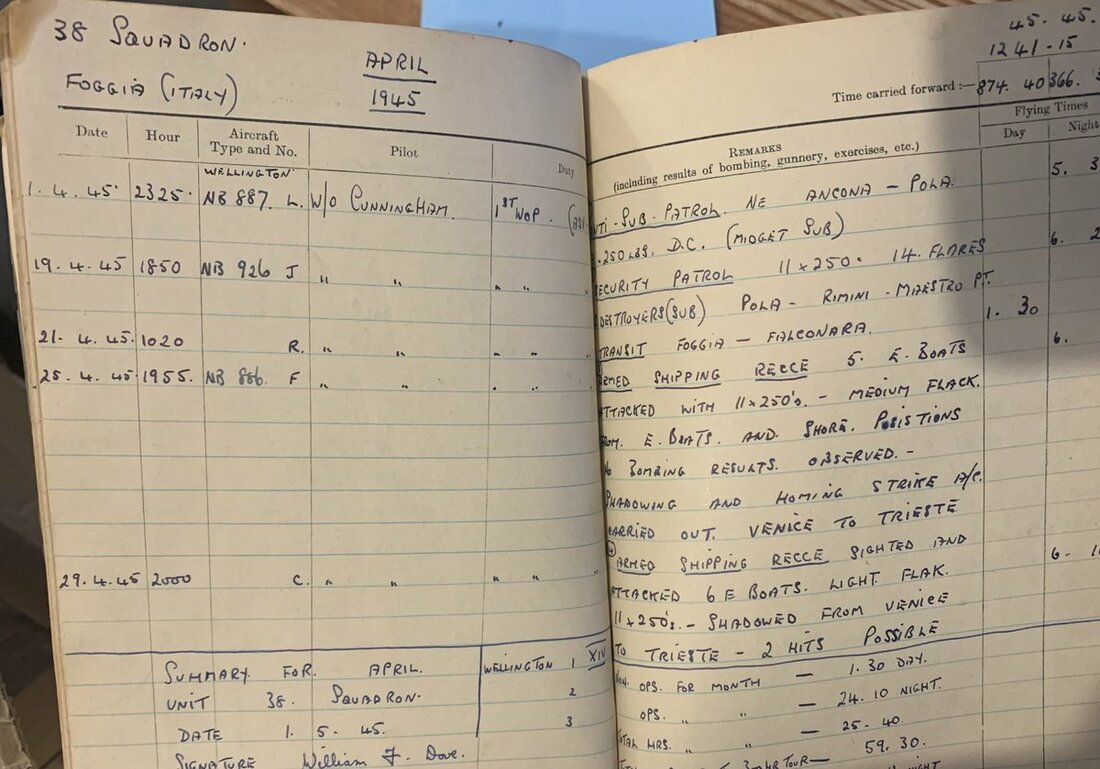Auction: 21001 - Orders, Decorations and Medals (conducted behind closed doors)
Lot: 643
(x) A fine Second World War and 'double-issue' campaign group of seven awarded to Flying Officer W. F. Dove, Royal Air Force, who flew on ‘Flying Milkmen’ relief flight duties over Greece in November-December 1944, and flew with No. 38 Squadron attacking E-Boats over the Adriatic in 1945, later flying with No. 114 Squadron during the Suez Crisis and with No. 38 Squadron over Cyprus
1939-45 Star; Italy Star; Defence and War Medals 1939-45; General Service 1918-62, 1 clasp, Cyprus (1122367 F.Sgt. W. F. Dove. R.A.F.); General Service 1918-1962, 1 clasp, Canal Zone (FS W F DOVE (1122367) RAF); Coronation 1953, mounted as worn, good very fine (7)
W. F. Dove, originally joined the Royal Air Force in May 1941, being posted to the Central Gunnery School, he began training in Dominie aircraft operating out of RAF Yatesbury, before being posted to RAF Castle Kennedy for further training from July 1941, and flying in Wellington bombers. He moved with his training unit to RAF West Freugh in late October 1941, and then joined No. 2 Signallers School Air Operation Section at Yatesbury in Wiltshire in early 1942, and gained further experience in Procter aircraft, before continuing his training from RAF Madley in Herefordshire from April 1942, and then RAF Jury from April 1942, where he learnt to fly in the Blenheim, serving as an Air Gunner and still undergoing training as an Air Signaller.
By May 1942 he was serving as a Wireless Operator 1st Class and flying in Blenheims and Hampdens out of RAF Jurby on the Isle of Man. By late 1942 he was flying in Anson aircraft in and around the Isle of Man with the School of Air Navigation. With the exception of a couple of searches for downed aircraft, he was generally employed and regional flights as part of the School of Air Navigation through to January 1944 when he was posted to RAF Hooton Park and joined No.13 Radio School on 2 February 1944.
Dove first saw service overseas when he was posted to join No.78 Operational Training Unit at RAF Ein Shemer in Palestine, and flying in Wellington bombers as part of ‘X’ Flight. His first operational service came when he was posted to join No.221 Squadron at Grotaglie in Italy in late August 1944, and began flying on operations in Wellingtons. With the war in Europe coming to an end, Dove moved with No. 221 Squadron to Kalamaki in Greece, and then became involved in the ‘Flying Milkman’ role, assisting the Joint Relief Commission in carrying six tonnes of canned milk to assist the starving women and children in the mountain fastnesses of the north-western Peloponnese during November 1944. Dove flew as part of Flight Sergeant Cunningham’s crew during this period, making relief flights on 14, 17, 18, and 26 November, and in a period of less than three weeks, in addition to the canned milk, the men of his Squadron delivered 1,200 blankets, 2,000 composite rations, 6,000 gallons of milk, as well as dropping some 6,000,000 leaflets over various parts of Greece. 221 Squadron was the first allied squadron to operate from Greece after the Allied occupation. On 8th December, his aircraft dropped some 400,000 leaflets, and then on the 12th December another 500,000, and on the 18th December some 750,000, all over the south eastern and south western peninsula of the Peloponnese. On 12 December, Dove found himself transferred to join No. 38 Squadron in Italy. He began further operations flying out of Foggia in Wellington aircraft from early February 1945, flying as a Wireless Operator and Air Signaller, and as such finally began bombing the enemy. On 6 March he performed an armed recce, dropping 18 x 250 lb bombs in the northern Adriatic, and signed a hospital ship at Venice. On 18 March he dropped a similar load during an armed recce in and around the Venice area. He performed similar sorties on 22, 23 and 29 March, as well as a mine clearance flight on 25 March. On 1 April he flew in an anti-submarine patrol from Ancona to Pola, and would appear to have attacked a midget submarine, and then on 19 April flew in a security patrol during which he appears to have attacked some destroyers / submarines. On 25 April he flew an armed shipping recce against E-Boats and experienced medium flak, and on 29 April flew in an armed shipping recce, during which he sighted and attacked six E-Boats, and experiencing light flak during the process, recording two possible hits. The war in Europe ended in May 1945, and with Dove now flying from Falconer, he flew in a mine-spotting flight on 5 May as well as a search for two destroyers, and after this conducted local flights. More mine-plotting occurred in June 1945, and he flew to Luqa in Malta in August 1945.
He was presumably on leave and not flying until early 1946, when he rejoined No. 38 Squadron at Luqa, and then performed a number of flights to Hassani in Greece at the time of the Greek Civil War. His last period flying at this time was in March 1946.
Dove next flying service occurred when he was posted to join No.4 Radio School at RAF Swanton Morley in July 1949, and flew as a Signaller in Anson aircraft. Dove was then posted to join No. 240 OTU for service with Transport Command from late August 1949, and then flew as a signaller in Valetta aircraft through to April 1950 when he was posted out to the Middle East to join No.114 Squadron at Kabrit in Egypt where his unit served as part of Transport Command and flying in Valettas. As such he was out there on the occasion of the outbreak of the Suez Crisis on 16 October 1951, and during this period performed local flights in Valetta’s as an Air Signaller, flying with ‘A’ Flight. He remained continually on service with his squadron out there till October 1952, with the Suez Crisis officially lasting through to 19 October 1954. Dove would later claim his General Service Medal with Canal Zone clasp after it was instituted in October 2003, being accidentally sent another Medal instead of the additional clasp to which he should have been issued. Dove continued with No. 114 Squadron, flying in an around the United Kingdom and other localities, and by the end of 1952 was flying in either Anson or Lincoln aircraft. Posted to the Training Wing of No.1 Air Signallers School in April 1954, he continued flying in Anson and Lincoln aircraft till posted to the Central Gunnery School at Leconfield in August 1954, and flew in Lincoln’s till posted to join No.1 School of Maritime Reconnaissance at RAF St Mawgan in November 1954, and flew in Lancaster’s, being rated at the end of the course as ‘Above Average’ as as Signaller and Radar Operator, and ‘Average’ at Sonics.
Dove thence joined No. 236 OCU at RAF Kinloss in March 1955, and here began to fly in the Shackleton as a Signaller, completing the conversion course in later April 1955. Dove then rejoined ‘A’ Flight of No. 38 Squadron in June 1955, the unit he had last flown with in early 1946, and now flying the Shackleton II aircraft.
Posted with this Squadron out the Mediterranean and Middle East in September 1955, he generally operated between Luqa in Malta and Idris in Tripoli. With the ongoing trouble with the EOKA Emergency in Cyprus having officially broken out in early April 1955, Dove got his first flight into Cyprus in April 1956, and took part in various aerial operations in relation to the operations on the ground from August-November 1956. On 9 November he flew in a first aid drop to the ‘Theseus’. A number of other flights to Cyprus occurred during 1957. Dove was then posted to No.1 Air Navigation School at RAF Topcliffe in February 1958 where he once again flew in the Valetta, and performed his last flight on 14 August 1958, having flown 3813 hours in total, of which 2806 had been in the day, and 1007 at night. Dove was later commissioned as a Flying Officer into the Cadet Force, and served in the Devon area in the mid 1970’s.
Sold together with his Flying Log Books, bound together, covering May 1941-August 1958, with a number of qualifications typed in, besides three photographs of him in service.
Subject to 5% tax on Hammer Price in addition to 20% VAT on Buyer’s Premium. For more information please view Terms and Conditions for Buyers.
Sold for
£320
Starting price
£320











